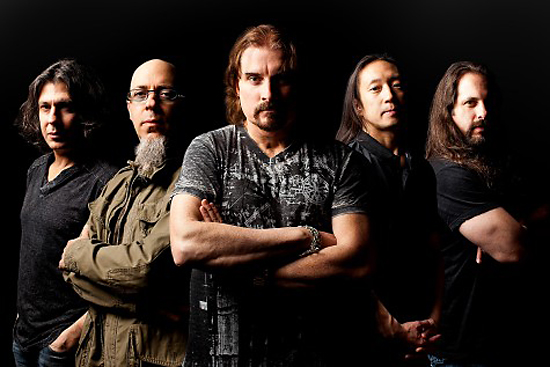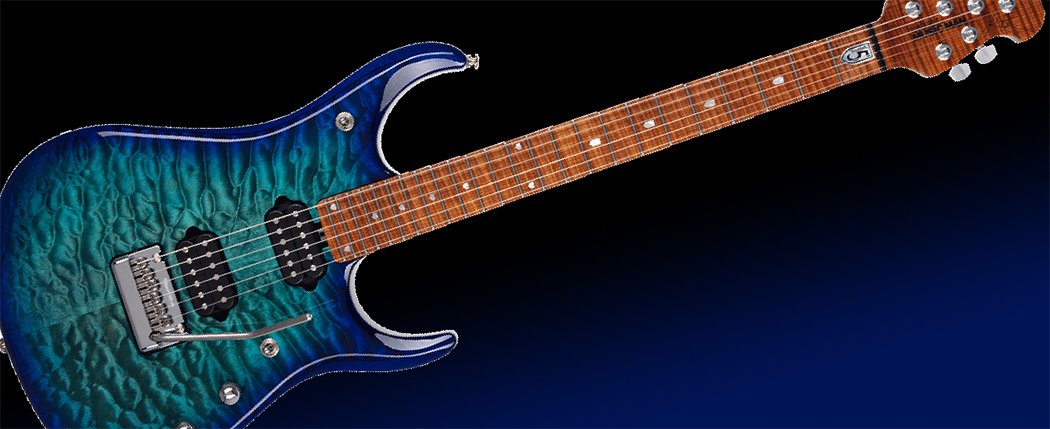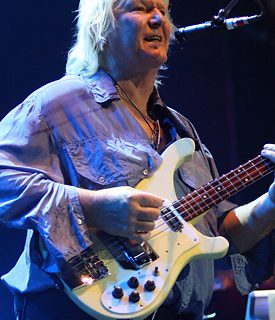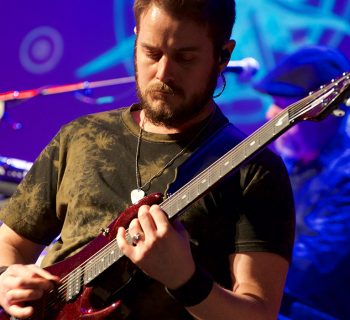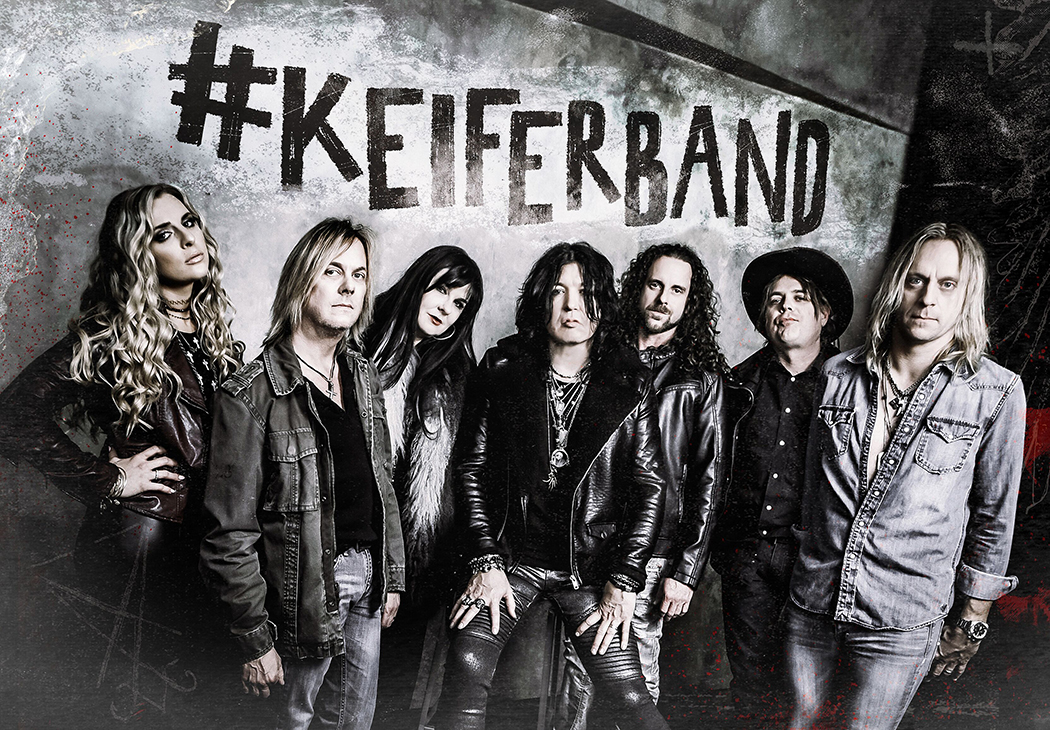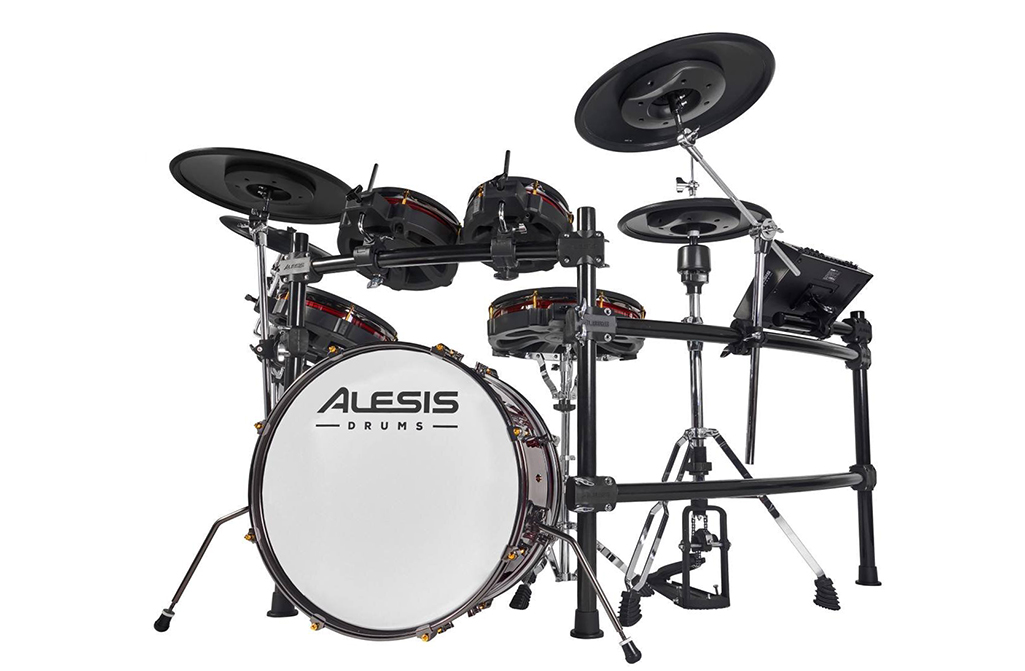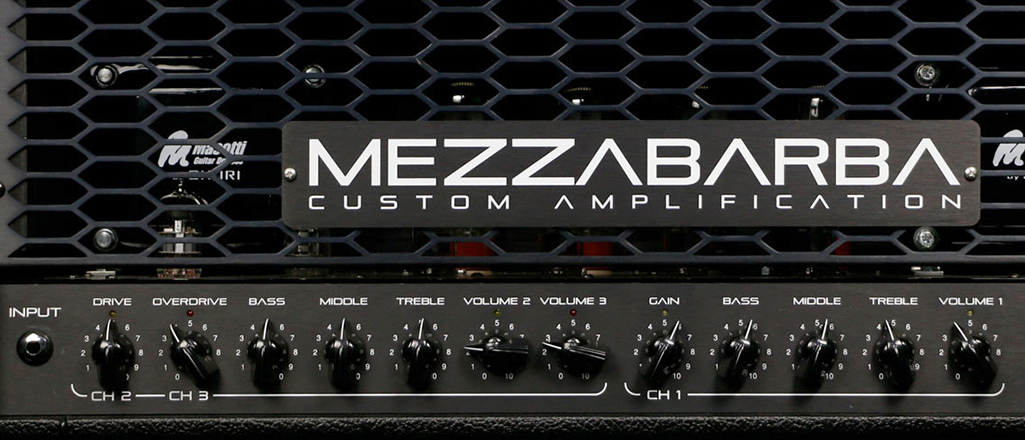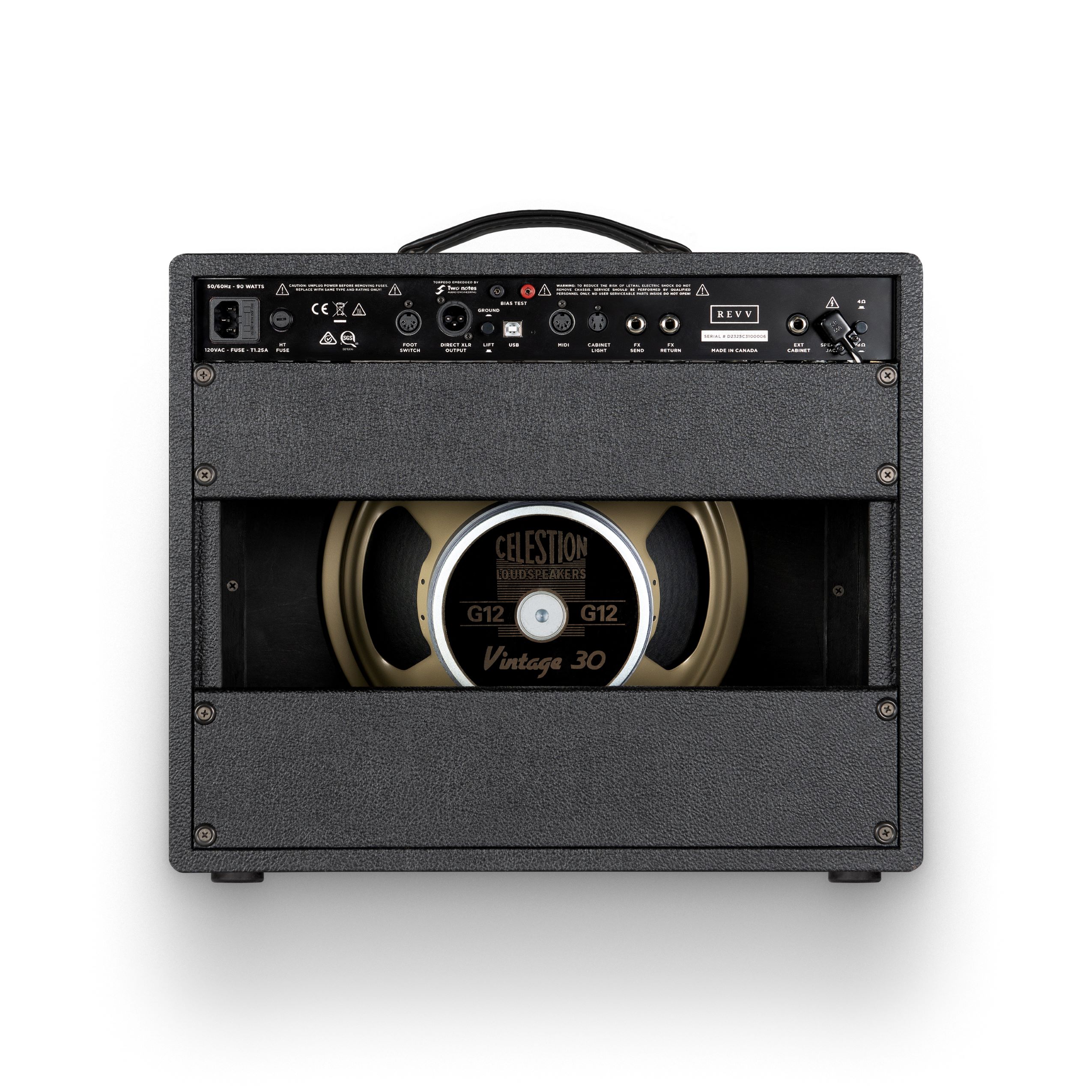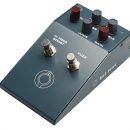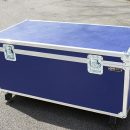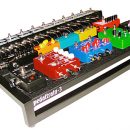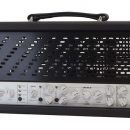John Petrucci rocks the Beacon Theater in New York City.
We just took every element and looked at those elements under a microscope.
MPc: I’ve been a fan of Dream Theater since the beginning, and A Dramatic Turn of Events definitely strikes me as a fresh step forward, and I think it’s one of the best Dream Theater albums ever. While I’ve enjoyed all of your band’s output, the past few CDs were starting to have a certain sameness to their sound and style. Not only was the music something of a return to form in terms of leaning a little more prog and a little less metal, but the production was noticeably better here, too. I know you handled the production duties by yourself this time around, and you did a killer job.
JP: To me it’s like, when we go in to do a record, no matter which one it is, we go in with all intent to make the best thing that we could make at that time. We put so much into it. I love everything, and by the time we’re finished with any record, I stand behind everything that we’ve done. Obviously, this one’s a bit different and it felt sort of special as we were writing it. But the positive feedback is, it’s so welcome because — from every level, as a guitar player and as a producer and lyricist and everything, you just put so much into it and it’s the ultimate to get the kind of reaction that you’re giving me, just… makes me feel great, really does.
MPc: The songwriting struck me as a more balanced set of songs compositionally, where everyone really got their moment to shine.
JP: Yeah, I thought that, I definitely felt that that was important, too. That balance word keeps coming up a lot. I think it’s important. I think it creates dynamics as far as the listening experience when you hear certain players featured at certain times and everybody’s just, you know, not only playing at their peak, but featured when they’re at those peak moments. It makes it really interesting. If you think about some of your favorite records and that great moment where you just play air drums on a fill or mimic the bass line that just happens or a guitar solo, whatever it is, those are some of the best moments on albums. It’s great to have the album sprinkled with all those moments. It really does create a more interesting listening experience, you know?
MPc: Yeah. Now I understand at the beginning of the process, you guys had some discussions about the future direction of Dream Theater. What were you thinking going into this record?
JP: The conversations we were having is, we said, listen, when we go in, the focus is we want to make a record that’s big, that’s well crafted. We want to play on the strengths of the band, the originality of the band. What is it that makes Dream Theater unique and special? And to try to go in those directions sort of farther than we ever have. So we had conversations like, you know, if we’re going to have a big, beautiful, soaring moment, then let’s make it the most cinematic moment that we can. Let’s really work on it, not only in the compositional sense, but also in the production, the sound, the way that it’s mixed and everything. You know, if we’re going to do some passages that are technical or complicated, then let’s really dive in, let’s come up with some sick shit, you know? That’s going to really twist the mind and catch people off-guard and take the music in a direction that’s maybe a bit unexpected. And when it came to composing the sections that would be vocal sections, let’s make sure that those vocal sections are as developed and unique as we can, that the chord progressions are moving in a way that is saying something and that the way the vocal melody’s interplaying really makes a lot of sense — the range where James is singing and everything.
So we (kind of) just took every element and looked at those elements under a microscope. So there was, like… you know, writing is part inspiration and part craft, and we spent a lot of time on [the craft]. You know, there’s no problem with the inspiration in this band, because everybody is just filled with so many ideas. But we spent, I think, probably more time on the craft part and I think in the end it made for a real special album.
MPc: Yeah, something that’s very obvious is that keyboards played a much bigger role in defining the sound, especially with the orchestration throughout.
JP: Right. Well, that’s a unique… one of the unique things about our band is that we’re a rock band and we have keyboards. There’s a lot of metal bands, progressive bands that are all guitars, which is great and it’s an awesome sound. But our band has keyboards. Not only do we have keyboards, but we have the best keyboard player on the planet. So it’s like we have the ability to exploit that in the sense that, when we orchestrate our music, we can use the keyboards to do lots of interesting counterparts to create atmospheric beds, to lift big guitar riffs in a cinematic way, with these kind of John Williams-esque melodies and things, to bring in more traditional elements, like piano and organ and stuff. Jordan’s capable of doing all that stuff. And we might as well exploit that and use that.
And, again, it makes for a more interesting listening experience. In my job as a producer is that there always has to be a balance, because this is a rock band. We’re a progressive metal band — there always has to be that edge and that attitude. And, at the same time, you shouldn’t be afraid of using the other sonic elements that everybody’s capable of delivering. So that was the attitude as far as the keyboards are concerned.

Is your guitar collection this well organized?
MPc: I read somewhere you described the listening experience for this record as a rollercoaster. You really created the album listening experience on this one.
JP: That’s great. You know, I appreciate that, because I’ve said this before, I sort of romanticize that people still listen to albums the way that I did when I was growing up and still like to: you put on the album as an experience, it’s kind of like watching a movie. You sit down, you put on headphones, shut off the lights and you get into it. And you have to listen to it several times, and you pick up on details that you might have missed the first time. So when we’re writing the album, when it’s being produced and mixed, I always have that in mind. I’m always thinking of the album as a whole, the listening experience. The way that it starts, the way it builds. Breathing moments, the way it climaxes. And even the ending, even the closing credits, which is sort of the “Beneath the Surface” section of the album.
What he did with the Octobans and matching the tones of the bass and the direction of the notes and everything was incredible.
MPc: I understand that you developed and programmed guide drum parts during the writing before Mike Mangini actually came in. Tell me, what was it like when he actually sat down to start playing drums with you guys on the new material?
JP: Oh, it was pretty incredible. Just to clarify, while we were writing the record, I wanted to make sure that we had fully developed songs and not just a bunch of riffs sort of pasted that we would have to go in and create songs out of. So, as we were writing those riffs and progressions and movements and segues and everything, I mean, we could have just put a click down and left it wide open, but I felt it was important to have some sort of basic blueprint as to what the feel of those sections were as they were being imagined and being written. And the drum programming was very simple. The last thing I wanted to do was sit for hours and hours programming detailed drums. So they were really just a blueprint.
And when Mike — he obviously had tons of time to internalize all that and, when he came in and started playing to the demo tracks, it was really remarkable, because it was literally like… it was like Frankenstein coming to life. He was like flipping the switch, you know, the whole — all of a sudden, you’re hearing a real drummer with his interpretation, his feel, his groove, his drum fills, his little things he’s catching, his personality and attitude and power. And all those elements that make him a great drummer that I, like I said, I wasn’t going to waste my time trying to even come close to in programming. It took it to the whole next level… that was a really defining moment of the recording process, because once he did that, then we went in and re-recorded all those scratch demo tracks to his drums. So now we’re catching all the little nuances and things that he’s doing, we’re adding parts based on what he’s doing. And, like I said, that was a real, real big moment for me in the recording process.
MPc: Okay. Cool, I was wondering, because some of the musical interplay, like in “Outcry,” where you’ve got this great musical interplay between you and Jordan and then it’s interspersed with solo bass lines from John Myung and I was wondering how the heck did you create something like that with Mangini in the picture in relation to—you had demo and then how on Earth do you come up with parts like that in demo form and then put it together with the drummer?
JP: Yeah, well, again, it’s just kind of a sketch guide drum that I was able to lay down. But him coming in and listening to those parts, I don’t know if it’s the same part you’re referencing, the part in “Outcry” where it’s kind of a drum and bass break, and what Mike, what he did with the Octobans and (kind of) matching the tones of the bass and the direction of the notes and everything was incredible. I would never have done something like that nor imagined it. I’m not a drummer, so it’s great to get his musical interpretation and creative mind on it, it was really incredible.
MPc: Andy Wallace’s mixing made a big difference in the sonic quality of A Dramatic Turn of Events.
JP: Yes.
MPc: Some of the differences, you can really hear John Myung’s bass lines really cutting through. And the keyboards… Jordan’s keyboards sound bigger than ever. And yet your guitar still sounds huge on top of all of it.
JP: Right.
MPc: And then James’s vocal are in a place that—it’s interesting, because I understand he tracked all of his vocals up in Canada, and you’ve got just a gorgeous vocal sound on top of the whole thing.
JP: Right. Well, thank you for all that. I think for me, part of being a producer is you have to sort of see — you have to see the whole picture from the beginning and have a goal as to what you’re trying to achieve. And then part of it is collecting the right team to make that happen. Between Paul Northfield, me working with him before and knowing that he is such a meticulous engineer and he’s able to get incredible sounds, that was step number one. Having conversations with James and saying, “Listen, as a vocalist, I want you to be comfortable, I want you to have the best performance and not be intimidated by anybody in the studio. I want you to be in a comfortable environment.” And that’s when we decided to bring in Rich Chycki to record him.
And then, of course, having Andy Wallace mix it and seeing that from the beginning I want him to mix the album and actually making that happen, I knew that he would mix it in a way that was powerful and polished and hi-fi and clear and you’d be able to hear the bass and the guitar would be huge and all those things that you mentioned.
So it’s part of wearing the producer hat, it’s putting all those pieces together and having a plan from the beginning, I think that’s really, really important in any project.
MPc: Did Paul do the actual tracking?
JP: Paul Northfield did the tracking. Yeah, he was the engineer on the whole album. And we did one at a time. I was there for every instrument, at the board with Paul and getting the best performances out of everybody. We started with drums and we did guitar, we did bass, keyboards, we did it in that order. Then solos and sound effects and stuff.
And the vocals, I mean, the way we did that, originally James was going to be with Rich right across the hall — there’s a couple of studios at [Cove] City. But just logistically it didn’t work out. Rich has a place up in Canada and we tried an experiment. Because, obviously, as a producer and a lyricist, I want James to have freedom to do what he wants to do as a vocalist, but I also want to be able to have input and approve and everything. And so we did an experiment where he would do it in Canada and send us the tracks. They actually came down to New York with the first two tracks and, as soon as I heard those, I was blown away. I was like, “You guys, this is ridiculous. This is going to work out great.”
And so I would write the lyric, I would demo it out and send it up to them. They would record it. A couple of days later, I’d get a file on the Internet and listen back and if there’s anything I needed to make comments on, I’d make a phone call. You know, the phrasing here, the pronunciation of this word here. Maybe redo this verse. Blah-blah-blah. All easy stuff. It was amazing. James, I was just blown away with everything I was getting back.
There were a couple of songs where I did, after a few times of doing it, it wasn’t quite hitting me the way I wanted, so I actually took a few days and went up to Canada with them and polished those up. But other than that, that’s the way we did it. And it was an amazing.
MPc: Great. Now let’s turn out attention to your guitars.
JP: Sure.
MPc: I’ve got a sense from what I’ve been hearing on the new songs that you played the majority of this record in standard tuning.
JP: Yeah, I did. Everything’s standard except for “Lost Not Forgotten,” which is tuned down to D. And three of the tracks use a 7-string, so it’s a low B, but it’s all standard.
MPc: I don’t even remember if I ever even asked you in the past [we’ve got a bunch of other Petrucci interviews online] — what strings do you use? What gauge?
JP: Well, Ernie Ball, of course. And it’s gauge 10 through 46.
MPc: Which of your Music Man guitars were you using?
JP: Well, this record, I used one guitar, or I should say one guitar model, which is my latest Music Man version, which is the JP Eleven. And I used that on all the songs. The seven-string versions for those tunes and the six-string for everything else. And that’s the one guitar that I use. It sounded so incredible, I had no reason to change or [laughs] move onto anything else, so that was it. And, for the acoustic parts, I used a Taylor acoustic. I have lots of gear, but the amount of gear for me in the studio was minimal. It wasn’t really a big gear-fest.
MPc: Now, one question that a number of guitar players have, maybe you could enlighten our readers about the difference in tone between your JPX and JPXI. What kind of difference does that chambered body in the X make in your guitar?
JP: You know, it’s hard to describe it. The X, it has a… how can I describe it? It has a little more resonance, like, a different kind of resonance to it. I find that I like to use it for certain types of things — it really sounds great on big, open chords and clean things, but I prefer the solid body for general riffing and stuff. I find it’s a tighter type of thing.
So the JPX with the chamber kind of introduces different resonance, so it has… the guitar’s just got a ton of sustain. It’s very alive. It’s probably more alive-sounding than any of the other guitars. It’ll give you different tonal possibilities as far as soloing and everything, but as far as using it when I’m doing heavy riffs and tight, chunky things, I prefer the solid body of the XI.
So I look at all the guitars, from the JP6 and the baritone, the BFRs, the X and the XI, it’s a line that I’ve been so fortunate to be able to develop with Music Man. And we always have this conversation. It’s like spices in the spice rack, you know? Hmm. This song could use a little oregano, you pull out the X.
So that’s the best way I can describe it.

A few Mesa/Boogie rigs. No wonder John is smiling!
MPc: Cool. Now let’s talk about the amps. Was everything [Mesa/Boogie] Mark V on this one?
JP: Yeah, everything was Mark V. I brought in the Mark V and that was to be my amp of choice. I had a Mark IIc+ in there and a Dual Rec — I think I brought in the Rectifier. I had them all set up, for comparisons’ sake. But everything ended up being the V in the end. I just found that I was able to get, really, all the best tones I was looking for out of that one amp. The clean was just gorgeous. The rhythm sound was really, really tight and just rich and chunky. And then the lead sound was very expressive and juicy. And I used a different mode on the amp for all three of those sounds, which is a total testament to how versatile that amplifier is. I mean, it does everything for me. Pretty incredible. It was a really great experience working with that amp. It was effortless.
MPc: Yeah, your lead playing is… you’re the poster child for Mesa/Boogie's “fluid, liquid Mark-series tone” [laughs].
JP: [Laughs] Oh, that’s cool. I appreciate that. They would love to hear that. That’s awesome.
MPc: Did you make any significant changes to your effects rig for this recording? I’m wondering whether or not you used the Axe-FX for some of the effects while tracking versus the usual assortment of things that I’ve seen in your rig.
JP: Sure. Well, just to go back for one second about the lead sound and the rhythm sound, just to show the versatility of that amp. The rhythm sound is the Mark IV of that amp. And the lead sound is the Mark IIc+ mode of that amp in triode setting with the tubes. And I had the gain kind of backed way down, so it sounds like there’s a lot of gain, but there actually was a lot less gain on the solos, which I think creates that kind of liquid-y, juicy sound that you’re talking about.
As far as the effects, it was really minimal. When we were writing the [album], I wrote the whole thing with the [Fractal Audio] Axe-FX, so all the demos and everything was that unit. And then, when we went to record, every so often there was a sound or a little thing that I did from the demo. It was like, you know what? That sounds really good, there’s no real reason to replay that. The little clean solo in “This is the Life,” towards the beginning, that was a demo Axe-FX track. The clean part in the breakdown of “Breaking All Illusions” before the guitar solo, that was a demo Axe-FX part. So, little parts like that I kept.
MPc: That’s so funny, because I actually had a question in my notes related to, “This is the Life,” which had a very different vintage-sounding guitar tone for some of the leads and rhythms in the verses.
JP: Right.
MPc: What did you do differently to get that tone?
JP: Oh, that’s funny. Well, the whole song is the V. The clean sound is the channel one of the Mark V. I used a TC Electronic Corona chorus. What I’ll do, I double track pretty much everything. And so what I do in a situation with a clean part is I’ll play one side clean and one side with the chorus on it, and double that with an acoustic. I usually kind of build that layered sound.
Like I said, the setup of all the rhythms and leads and everything is just the V, and sometimes in that song in the middle, when there’s a little piano kind of Elton John thing, I sort of backed the gain way down, just so it almost has… it’s not a full-out distorted sound, this way when the next section kicks in, it’ll be heavier. That little clean break, like I said, that was the Axe-FX from the demo, just a clean, direct sound with some compression and delay on it.
Some of those approaches and some of those difference in feel have to do, I think, with the arrangement, too, and the playing style. You know, you have a little organ behind you and you’re kind of playing in a Jimmy Page way. It sort of gives you that feeling of a more vintage-y sound, but it’s actually all the same gear, it’s not like I changed guitars or anything like that.
MPc: And did you get all of your gain from the Mark V, or did you goose it with any overdrive or boost pedals going into it?
JP: No, no overdrives. It’s all the Mark V. All the rhythms… my recording setup’s really, really simple. Just guitar, really good Mogami cable into the V, out to a Mesa/Boogie 4x12 Rectifier cabinet with Celestion Vintage 30s and two microphones on the amp and that’s it. It’s just real, real simple. So no gain boosts, no overdrives, no anything like that. It’s all the pure sound of the amp.
MPc: Great. How did you mike your cabs, and which mics did you use?
JP: Well, we used two microphones. We used an [Shure] SM-57 and we used a Shure ribbon mic, [the KSM353]. It’s a new one, it’s about a $3,000 mic. We had demoed a whole bunch of mics pres before the session started. We ended up going for a Shadow Hills mic pre, which is frickin’ awesome. And a Universal Audio as well. And that was it. There’s an equal blend of both microphones. I dial in a good sound with the amp, put up the mics in the sweet spot, stand right in front of the studio monitors and tweak it until it sounded like I was standing in front of my cabinet again. So that’s pretty much how I got the sound.
MPc: Do you pan those mics out or do you stack them?
JP: No, they’re stacked. It’s just a combined sound. And then I double-track the guitars, so I do two passes for every part.
MPc: So you track in mono and then pan those out for the stereo sound on the album?
JP: Yeah, so it’s one pass, two microphones. Pan to the left. One pass, both microphones, pan to the right.
MPc: Your Taylor acoustic played a much more prominent role on this record than on any previous Dream Theater albums that I can think of. What was your approach to recording the acoustic guitar?
JP: Well, you know, that’s the area that I leave up to Paul [Northfield, engineer]. Because acoustic is funny. It’s like, you get a great instrument, it’s just, everything’s coming from the instrument, there’s no amplifier or anything. So the guitar has to sound great, first. Which the Taylors do, of course. And then it’s just like, “Paul, capture this, make it sound great.” And he tried a bunch of different microphones on it and positions until he would say in the control room, “Okay, that sounds great.” And I would hear it in the headphones, sounding awesome. And that’s it.
And, a lot of those acoustics, I’ll double track, so I’ll do two passes and we’re just trying to capture the natural sound of the instrument without really any ambience or any other elements getting in the way.
I record everything… at two different speeds. Real slow, so if I have to go back and reference, I can pick it up, and then the normal speed.
MPc: “Breaking All Illusions” opens with a really great example of the harmonized melody lines that you play in a variety of places throughout A Dramatic Turn of Events. And what I feel like I’m noticing is that your guitar tone sounds a little bit different on each of your lines. I’m wondering about if you could talk about your approach to tracking your harmony lines.
JP: Sure. Actually, the start of “Breaking All Illusions” is an illusion. Because it’s the same exact guitar sound on everything. When I track the rhythms of the album, I set the amp and didn’t touch it, so the same rhythm sound that’s on “Bridges in the Sky” is the same one that’s on “Breaking All Illusions,” just the six-string versus the seven-string. And the harmony line is actually the keyboard. So the guitar is just double tracked in unison and the keyboard’s playing the harmony.
MPc: There are so many harmony lines that are interplayed between you and Jordan throughout this record. How do you guys develop those sections? Do you write out notation or tabs for your parts, or do you just commit the lines to memory?
JP: Well, when I’m first writing them, I commit them to memory. I write down anything that I think I’m going to have trouble remembering. And, of course, I record everything, and I record it at two different speeds. Real slow, so if I have to go back and reference, I can pick it up, and then the normal speed.
And, generally, if I write a guitar line and the intent is to have a harmony, I’ll play it for Jordan, he’ll notate it and I’ll say, “All right, write a harmony.” And he’ll write a harmony. And then we’ll try it, he’ll take a few minutes, he’s writing and playing and then he’s, like, “All right, John, check this out.” And he’ll come back with something. And that’s how it’s done.
And then, when we track, I’m really particular about going first. I like to lock in the line with the drums, really, really tight, because the guitar is so percussive. So if the guitar is out in any way, you’re going to notice it. So then that’s the bed that Jordan will lay his harmony to. Keyboards always seem to me to have a little bit of leeway as far as the way that the attack hits, whereas the guitar, I have a percussive sound with the pick and if it flams with any drum or anything like that, it’s going to be noticeable. So I lay down first and then Jordan lays down his unison lines and any harmonies on top of that.
MPc: Let’s talk briefly about lyrics. You wrote the majority of the lyrics for this album and John Myung — a lot of people were very excited to hear that he added a new lyric contribution.
JP: Writing lyrics is something that I’ve always had a passion for. I’ve always been into lyrics as, you know, growing up listening to bands and getting into Rush and Floyd and just really into the message in songs and certain lyrics would hit me and I would write them down in notebooks and on desks and things like that and they just became a part of my memories growing up. So I come, kind of, from that school.
You know, the biggest thing to me is that the lyric has to match what the song is saying by the feel of the song. If the lyric’s subject matter is off from the song, that’s the worst thing for me and you immediately, immediately notice that, it’s so evident. It’s like something just isn’t right. So subject matter has to match the feel of the song.
We do write the melodies first, which I think is really important. And those melodies will sort of dictate the phrasing, so then I have a guideline that I need to write words to. You’re not just writing freeform and sticking them in, they’re actually musically phrased within the context of composition.
And I go for sounds of words and the ways that words are developed and accented and it’s really, really important to me. You can’t have awkward-sounding words and strange emphasis on the wrong syllables and things like that. It has to… that has to be right.
And then, you know, whatever you’re writing about, the story has to be compelling or the idea has to be complete. I like to use tons of metaphors and tons of references, phrase references and things like that. And that’s the story.
In the case of John’s composition lyrically, for “Breaking All Illusions,” it’s very similar to the last time… to any song John’s written. He usually writes a lot of words in a sort of free form, if you will. And then it’s a matter of me going in there with him and crafting it into a lyric. Which, all those things I’m talking about, like rhythms and phrasing and syllable placement and all that stuff, that’s not something that John really focuses in. So I need to go in there and make that happen because ultimately it has to be sung and it has to sound natural being sung. Phrases have to work for [James] in order for it to be convincing. You can’t just have all this esoteric sort of prose and then try to sing it; it doesn’t work that way.
So that’s the working relationship that I’ve had with John lyrically from the beginning. And this time around he was, like, “You know what? You got to take credit this time.” So we put that on there, the lyrics by Myung and myself, because of all the time spent in that crafting department was something that he valued.
The rig is simplified in that way. [I’m] going for purity of tone.
MPc: Great. And finally in closing... Any surprises we might look forward to on the new tour?
JP: Well, very early on, we had a pretty big meeting with our production team as to our goals as far as the way we wanted the show to be presented. And much in the way that we had the conversations about the album and that sort of crafting part, we wanted to carry that over into our live presentation. We have so many great guys that work with us on our team that are master lighting directors, video directors… So we have been working to get the content of our show right as far as the way that it’s presented: the lights, the video content, the story, the message that’s going on, the design of the video presentation, and the stage. All that is going to be very, very tied in this time with the whole show.
So I think that people will definitely notice a difference as far as the impact visually of the show. I’m really looking forward to it. We did the festivals and we didn’t really have our full production, so first show in San Francisco will sort of reveal what we’re talking about.
 MPc: Cool. Will you be taking out one of the familiar rigs that we dissected in my book?
MPc: Cool. Will you be taking out one of the familiar rigs that we dissected in my book?
JP: We will. I will be taking out the very rig [the Mark V rig]. By the way, your book came out awesome, I love it.
MPc: Thanks!
JP: That is right up my alley. So glad you wrote that. Now I want to buy more stuff! [laughs]
MPc: Excellent. [laughs]
JP: Great, great, great job and thanks for featuring my guitar on the cover and my rig, that was so cool! The rig that I’ll be using on the tour is one of the ones you have featured in your book. It might even be on the cover, where it shows the two Mark Vs, the Dunlop rack wah, and the Axe-FX, except I just recently got the Axe-FX II, so we’re going to put that in instead.
And the only other addition we did, because it was a lot of fun and I have an affinity towards pedals and stuff, because we added a pedal board. It’s a little pedal board with four stomp boxes that we put in there just to have the [options], and they’re switchable via the system, so it’s just sits at the top of the rack and I’m able to bring in one of my favorite pedals, a certain flanger or compressor pedal, whatever it is. So we added a little bit more fun to it. But the only multi processor is the Axe FX II.
MPc: So you’re leaving home the [TC Electronic] 2290s?
JP: Yeah. This rig is very simple. No 2290s, no M3000s, no Eventide. It’s just very scaled down.
You know, one of the goals — I mean, I love those big rigs, they sound frickin’ amazing. But one of the things we talked about earlier (about our recording process), how I just plug into the amp. That magic is something I’m always trying to strive for live. And unless you just plug into the amp and you don’t have any effects and you just brave it, you’ve got to add some elements into it. If you want delays or pedals, of course. So the more you’re adding in, the more you’re venturing away from that purity. So I wanted to make a rig that was super simple, that just had one processor. You know, one pedal at a time if I needed one in the front and that’s it. And just the heads in stereo.
So that’s why the rig is simplified in that way. Going for purity of tone.
MPc: Which foot controller are you using? I know you were checking out the Fractal Audio controller when you got the Axe-FX.
JP: The Axxess Electronics FX1. I’ve been using it forever, it’s consistent in all of my rigs, so I’m sticking with that.

